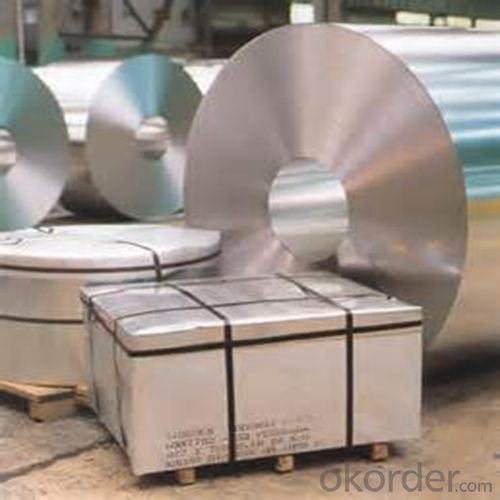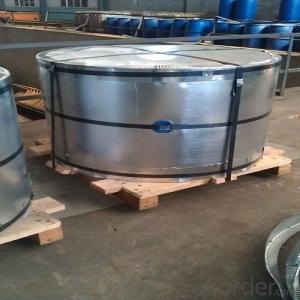Quality Electrolytic Tinplate Coils or Sheets For Tin Containers
- Loading Port:
- Tianjin
- Payment Terms:
- TT OR LC
- Min Order Qty:
- 25 m.t.
- Supply Capability:
- 15000 m.t./month
OKorder Service Pledge
OKorder Financial Service
You Might Also Like
Item specifice
1.Structure of Quality Electrolytic Tinplate Coils or Sheets For Tin Containers Description
Electrolytic Tinplate, is one thin steel sheet with a coating of tin applied by electrolytic deposition. Tinplate made by this process is essentially a sandwich in which the central core is strip steel. This core is cleaned in a pickling solution and then fed through tanks containing electrolyte, where tin is deposited on both sides. As the strip passes between high-frequency electric induction coils, it is heated so that the tin coating melts and flows to form a lustrous coat.
2.Main Features of the Quality Electrolytic Tinplate Coils or Sheets For Tin Containers
Formability and strength – Tinplates have got very good formability and strength. By selecting a proper temper grade, appropriate formability is obtained for different applications as well as the required strength after forming.
Corrosion resistance – Tinplate has got good corrosion resistance. By selecting a proper coating weight, appropriate corrosion resistance is obtained against container contents. Coated items should meet 24 hour 5 % salt spray requirement.
Hygienic – Tin coating provides good and non toxic barrier properties to protect food products from impurities, bacteria, moisture, light and odours.
Safe – Tinplate being low weight and high strength makes food cans easy to ship and transport.
Tin is not good for low temperature applications since it changes structure and loses adhesion when exposed to temperatures below – 40 deg C.
3.Quality Electrolytic Tinplate Coils or Sheets For Tin Containers Images


4.Quality Electrolytic Tinplate Coils or Sheets For Tin Containers Specification
Specification of :
Standard: ISO 11949 -1995, GB/T2520-2000,JIS G3303,ASTM A623, BS EN 10202
Material: MR,SPCC
Thickness:0.15mm - 0.50mm
Width: 600mm -1150mm
Temper: T1-T5
Annealing: BA & CA
Coil Inner Diameter: 508mm
Weight: 6-10 tons/coil 1~1.7 tons/sheets bundle
Passivation:311
Oil: DOS
Surface: Finish,bright,stone,matte,silver
5.FAQ of Quality Electrolytic Tinplate Coils or Sheets For Tin Containers
- How are the tinplates specified?
The tinplates are specified as per the steel base, extent of tempering, the coating weight, annealing method and the surface finish.
- How many types there are for base steels?
The base steels are of three types: Type MR, L, D
- Q:How does tinplate affect the overall barrier properties of packaging?
- Tinplate enhances the overall barrier properties of packaging by providing a protective layer that effectively prevents the transfer of oxygen, moisture, and light. This barrier helps to preserve the quality, freshness, and shelf life of the packaged product, ensuring its integrity and safety.
- Q:What are the common printing and decoration techniques for tinplate?
- The common printing and decoration techniques for tinplate include lithography, offset printing, hot stamping, embossing, and varnishing.
- Q:How is tin coating applied to the steel substrate?
- Tin coating is applied to the steel substrate through a process called electroplating. In this process, the steel substrate is immersed in an electrolyte solution containing tin ions. An electric current is then passed through the solution, causing the tin ions to be attracted to and deposit onto the steel surface, forming a thin layer of tin coating.
- Q:Can tinplate packaging be used for clothing accessories?
- Yes, tinplate packaging can be used for clothing accessories. Tinplate is a versatile material that can be molded into various shapes and sizes, making it suitable for packaging small items like clothing accessories. It offers durability, protection, and a visually appealing aesthetic, making it an excellent choice for packaging these types of products.
- Q:What are the main regulations governing the use of tinplate in different industries?
- The main regulations governing the use of tinplate in different industries vary depending on the country and industry. However, some common regulations include ensuring food safety and compliance with packaging standards, such as the Food and Drug Administration (FDA) regulations in the United States. Additionally, there may be regulations related to environmental impact, recycling, and waste management. It is essential for businesses to stay updated with local regulations to ensure the safe and compliant use of tinplate in various industries.
- Q:Can tinplate be used for pet food packaging?
- Yes, tinplate can be used for pet food packaging. Tinplate is a commonly used material for food packaging due to its durability, corrosion resistance, and ability to preserve the quality and freshness of the contents. It is also safe for storing and packaging pet food products.
- Q:Can tinplate packaging be used for non-food items?
- Yes, tinplate packaging can be used for non-food items. Tinplate packaging is a versatile and durable material that can be used for various purposes including packaging non-food items such as cosmetics, pharmaceuticals, household products, and more. Its protective properties make it suitable for a wide range of products that require stability, durability, and visual appeal.
- Q:How can the section of the tinplate be maintained without rust?
- Heat the pot, wipe with fat pork and pig skin, over five minutes, and never rust again
- Q:What are the different types of tinplate seams?
- The different types of tinplate seams include lap seams, double seam, triple seam, and lock seam.
- Q:What are the main applications of tinplate in the beverage industry?
- Tinplate is mainly used in the beverage industry for the production of cans and packaging materials. It provides a protective barrier against corrosion, ensuring the product's integrity and extending its shelf life. Tinplate cans are lightweight, easily stackable, and offer convenient storage and transportation. Additionally, tinplate's ability to be printed and decorated makes it ideal for branding and marketing purposes in the beverage industry.
1. Manufacturer Overview |
|
|---|---|
| Location | |
| Year Established | |
| Annual Output Value | |
| Main Markets | |
| Company Certifications | |
2. Manufacturer Certificates |
|
|---|---|
| a) Certification Name | |
| Range | |
| Reference | |
| Validity Period | |
3. Manufacturer Capability |
|
|---|---|
| a)Trade Capacity | |
| Nearest Port | |
| Export Percentage | |
| No.of Employees in Trade Department | |
| Language Spoken: | |
| b)Factory Information | |
| Factory Size: | |
| No. of Production Lines | |
| Contract Manufacturing | |
| Product Price Range | |
Send your message to us
Quality Electrolytic Tinplate Coils or Sheets For Tin Containers
- Loading Port:
- Tianjin
- Payment Terms:
- TT OR LC
- Min Order Qty:
- 25 m.t.
- Supply Capability:
- 15000 m.t./month
OKorder Service Pledge
OKorder Financial Service
Similar products
New products
Hot products
Hot Searches
Related keywords



























